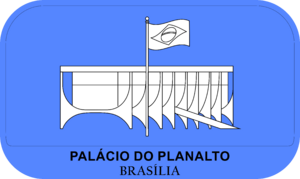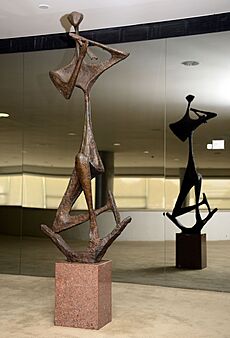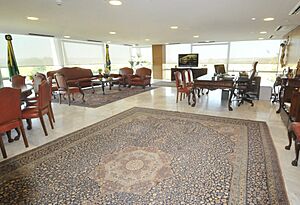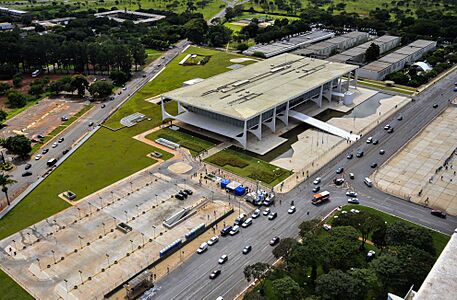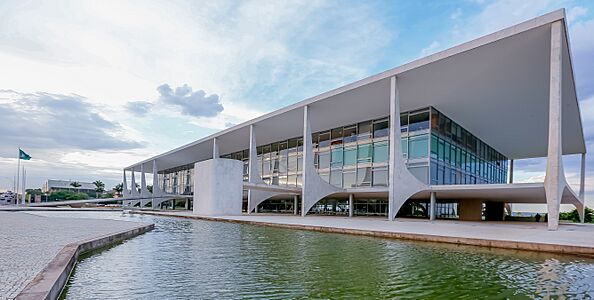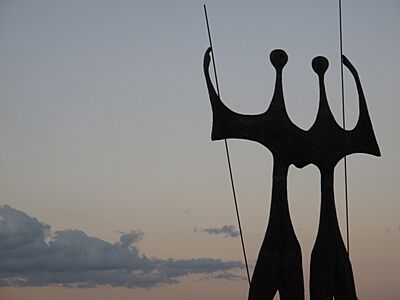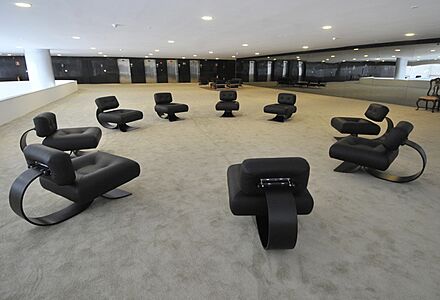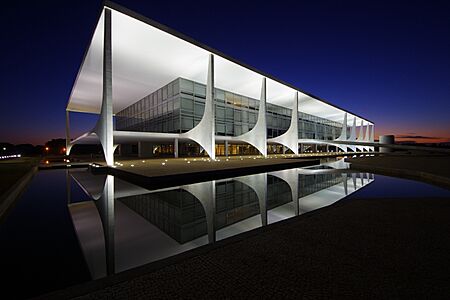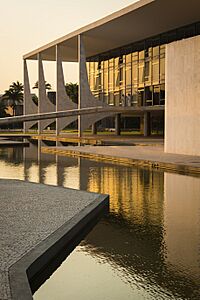Palácio do Planalto facts for kids
Quick facts for kids Planalto Palace |
|
|---|---|
|
Palácio do Planalto (Portuguese)
|
|
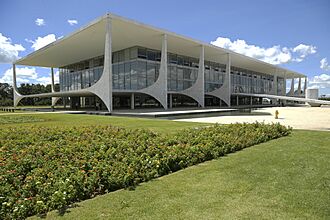 |
|
| General information | |
| Architectural style | Modernist |
| Location | Praça dos Três Poderes, Brasília |
| Country | Brazil |
| Elevation | 1,172 m (3,845 ft) |
| Current tenants | Luiz Inácio Lula da Silva, President of Brazil |
| Construction started | 10 July 1958 |
| Inaugurated | 21 April 1960 |
| Renovated | 2009–2010 |
| Client | Brazilian government |
| Owner | Brazilian government |
| Height | 65.65 ft (20.01 m) |
| Technical details | |
| Floor count |
|
| Floor area | 36,000 m2 (390,000 sq ft) |
| Design and construction | |
| Architect | Oscar Niemeyer |
| Other information | |
| Parking | 500 vehicles (underground) |
| Criteria: | Cultural: (i), (iv) |
| Designated: | 1987 (11th session) |
| Part of: | Brasilia |
| Reference #: | 445 |
| Region: | Latin America and the Caribbean |
|
National Historic Heritage of Brazil
|
|
The Palácio do Planalto (which means "Highlands Palace") is a very important building in Brasília, Brazil. It is the official office for the president of Brazil. This amazing building was designed by a famous architect named Oscar Niemeyer in 1958. It officially opened on April 21, 1960.
Since it opened, every Brazilian president has worked here. The palace is located in a special area called the Praça dos Três Poderes (Three Powers Plaza). This plaza is home to Brazil's most important government buildings. The Planalto Palace is next to the National Congress of Brazil and across from the Supreme Federal Court.
The Planalto Palace is one of the main buildings used by the President. The official home of the President is the Palácio da Alvorada. Many other important government officials also work at the Planalto, like the Vice-President. Because it is the main office for the government, people often use the word Planalto to mean the executive branch of the Brazilian government.
The building has a modernist style. It is part of the Brasília World Heritage Site, which was recognized by UNESCO in 1987. This means it's a place of special importance to the world.
Contents
History of the Planalto Palace
The idea for a presidential palace was a big part of the plan for Brazil's new capital city, Brasília. Oscar Niemeyer was chosen to design the Palácio do Planalto. Construction started on July 10, 1958. While the palace was being built, the President's office was in a temporary place called the Catetinho.
The palace officially opened on April 21, 1960. President Juscelino Kubitschek was the first to use it. It was one of the first important buildings to open in Brasília, along with the National Congress and the Supreme Federal Court. Many leaders from other countries came for the opening. Thousands of people watched the ceremony. It was a big moment because it showed that Brazil's capital had moved from Rio de Janeiro to the center of the country.
The palace gets its name from the Brazilian Highlands (planalto means highland). Brasília is located on the Brazilian Central Plateau, which is a highland area.
Palace Restoration (2009–2010)
In March 2009, President Luiz Inácio Lula da Silva decided the palace needed a big renovation. The building was built in 1958, and years of not enough care had made it quite old. The restoration finished on August 24, 2010. It cost about R$111 million (Brazilian Reais).
The renovation fixed many things. They put in new electricity, water, and air conditioning systems. They also changed the inside rooms and built new walls. The outside marble and granite were cleaned and repaired. A new underground parking garage was built for 500 cars. They also replaced the power generators, fixed windows and doors, and added emergency stairs. All the technology inside was updated too.
While the palace was being fixed, the President's office moved to other buildings temporarily.
Attack on the Palace (2023)
On January 8, 2023, the Planalto Palace was attacked. Supporters of a former president entered the building.
Palace Design
The presidential palace was a key part of the plan for Brasília. Oscar Niemeyer wanted the building to look simple and modern. He used smooth lines and curves for the columns and outside parts. The palace has many columns that create a special look.
The front of the palace has two important features. There is a long ramp that leads to the main entrance. There is also a parlatorium, which is a speaker's platform. From here, the president and other world leaders can speak to the public gathered in the Three Powers Plaza.
A reflecting pool was added in 1991. It helps make the palace more secure. It also helps keep the air moist during Brasília's long dry season. The pool is about 1,635 square meters (17,600 sq ft) and holds 1,900 cubic meters (67,000 cu ft) of water. It is about 110 centimeters (3.6 ft) deep. Many Japanese carp fish live in the pool.
Inside the Palace
The Planalto Palace covers an area of 36,000 square meters (387,500 sq ft). The main building has four floors above ground and one floor underground. There is also a heliport (a place for helicopters to land) on the north side of the building.
First Floor
The first floor is where visitors arrive. It has the main reception area, security checks, and a press office. The large entrance hall often hosts temporary art exhibitions about government programs. You can see sculptures by Franz Weissman and Zezinho de Tracunhaém here. This floor also has the Presidential Gallery, which displays official pictures of all past presidents of Brazil.
Second Floor
The second floor has several important rooms. These include the East, Noble, and West rooms, plus the Supreme Meeting Room and the Press Secretariat. The East Room is where the president signs new laws and official documents.
The Noble Room, also called the Mirror Hall, is the biggest room in the palace. It is used for large events and can hold up to 1,000 guests. Here, you can see a sculpture by Haroldo Barroso and a painting by Djanira da Motta e Silva. The West Room is for medium-sized events, holding 300 to 500 people. It is often used for international meetings. A large artwork by Roberto Burle Marx decorates this area. The Supreme Meeting Room was built in 1990. It is used for meetings between the president and their ministers or other government officials.
Third Floor
The third floor is where the president's main office is located, along with offices for their top staff. There is also a large mezzanine area with waiting rooms. These rooms have furniture by famous designers like Sergio Rodrigues and Oscar Niemeyer. You can also see paintings by artists such as Emiliano Di Cavalcanti and Frank Schaeffer. A bronze sculpture called O Flautista by Bruno Giorgi used to be here, but it was damaged during the attack on January 8, 2023.
The president's office has three parts: the main office, a meeting room, and a guest room. The office is decorated with modern Brazilian furniture from the 1940s to 1960s. It also has silverware from the Catete Palace. Two large paintings by Djanira da Motta e Silva are highlights in this room. The meeting room is for private discussions with staff. The guest room is for formal meetings with leaders from other countries.
Fourth Floor
The fourth floor has a large lounge area and offices for other senior government officials. This includes the Chief of Staff and the Chief of the Institutional Security Cabinet. The lounge area was created during the 2010 renovation. It has modern Brazilian furniture from the 1960s. You can see a tapestry by Alberto Nicola, a sculpture by Bruno Giorgi, and a painting by Giovanni Oppido. Two large artworks by Athos Bulcão are also on the walls leading to the lounge.
Visiting the Palace
The Planalto Palace is open for public visits on Sundays, from 9:30 AM to 2:00 PM. The guided tours last about 20 minutes. During the week, only authorized people can enter the building. It's usually hard to see the president, as they often enter through a special entrance or arrive by helicopter.
The ramp in front of the palace is only used for very special events. These include presidential inaugurations and visits by foreign leaders.
The palace is protected by the Presidential Guard Battalion and the 1st Guards Cavalry Regiment (known as the 'Independence Dragoons'). These units are part of the Brazilian Army. They take turns guarding the palace every six months. A special ceremony called a change of the guard happens when they switch duties.
Gallery
See also
- Alvorada Palace
- Granja do Torto
- Rio Negro Palace
- Catete Palace
- Paço Imperial
- Palace of São Cristóvão
- Petrópolis Imperial Palace
- List of Oscar Niemeyer works
- 2023 invasion of the Brazilian Congress




